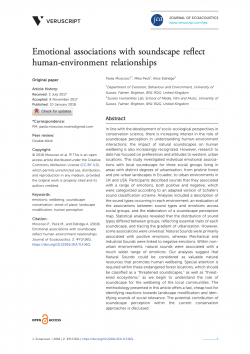Perceived Soundscape Experiences and Human Emotions in Urban Green Spaces: Application of Russell’s Circumplex Model of Affect

Type
Journal
Authors
Category
Article
[ Browse Items ]
Publication Year
2024
Publisher
URL
[ private ]
Volume
14
Issue Period
13
Pages
5828
Tags
Abstract
Humans perceive their surrounding environments largely through their experiences of sight and hearing. The perceived environmental information then brings on neurophysiological changes, so as to influence human emotions. These mutually influenced relations have been widely utilized by many environmental psychologists to explore potential avenues for improving human emotions through design interventions. However, to date, no efficient and accurate way has been established to describe these relationships. Inspired by Russell’s model of emotion, this study aims to develop an efficient process that uses coordinate mapping and can intuitively describe the impact of visual-aural perceptive attributes on human emotions. Taking typical urban green spaces (UGSs) in Chengdu as examples, this study first measured the visual and aural characteristics of study sites perceived by people and their emotional responses. The study then established the use of emotional status on a coordinate axis, allowing each visual-aural attribute corresponding to each emotional response to be projected onto the coordinates. Results suggested that the dataset composed of 279 evaluations could be classified into three distinct types of visual-aural settings and the distribution of emotions is evidently varied in different settings. It was found that aesthetic and order of visual aspects as well as eventful and harmonious soundscape in environments are more likely to make people feel pleasure, while openness and layering of the visual landscape can easily arouse people’s positive status. The research outcome broadens the practical path of soundscape research, centring on human emotions, experiences and feelings, such as the pleasantness and arousal raised in Russell’s theory of emotion. The study also makes an empirical contribution to the design of UGSs based on multi-sensory perception and serves the purpose of improving people’s environmental experiences.
Description
https://www.mdpi.com/2076-3417/14/13/5828
Number of Copies
1
| Library | Accession No | Call No | Copy No | Edition | Location | Availability |
|---|---|---|---|---|---|---|
| Main | 758 | 1 | Yes |
